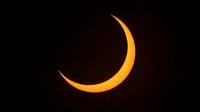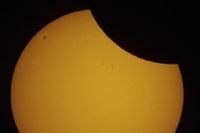Stargazers and astronomy enthusiasts across the Southern Hemisphere are gearing up for a rare celestial spectacle: the final partial solar eclipse of 2025. On Sunday, September 21, the Moon will glide between the Earth and the Sun, obscuring a portion of the solar disk and transforming the sky into a dramatic tableau of light and shadow. This event, the fourth and last eclipse of the year, promises a stunning crescent-shaped Sun for those in the path of visibility—namely, Antarctica, New Zealand, and a sliver of Australia.
According to AP News, the eclipse will unfold on Monday local time in the Southern Hemisphere, just two weeks after Asia was captivated by a total lunar eclipse that turned the Moon blood-red. The sequence of 2025’s eclipses began with back-to-back solar and lunar events in March, culminating now in this partial solar show. As India Today explains, the phenomenon occurs when the Moon passes between the Earth and the Sun, but only blocks part of the Sun’s disk. Instead of the Sun being completely hidden, it appears as if a “bite” has been taken out of it—a sight both mesmerizing and fleeting.
The mechanics behind this event are rooted in the interplay of the Moon’s shadow. The umbra, or the dark central shadow, causes a total eclipse for those standing within it. However, during a partial solar eclipse, observers find themselves in the penumbra, the lighter outer shadow, where only part of the Sun is covered. This means the Sun will not disappear entirely but will instead adopt a striking crescent shape, creating a unique sky scene that can only be witnessed from specific regions along the Moon’s shadow path and only during a new moon.
The timing of the eclipse is precise. As reported by India Today, the partial solar eclipse will begin at 17:29 UTC (10:59 PM IST on September 21), reach its maximum at 19:41 UTC (1:11 AM IST on September 22), and conclude at 21:53 UTC (3:23 AM IST on September 22). The entire event will last for over four hours, offering ample opportunity for those in the Southern Hemisphere—particularly in New Zealand, parts of Australia, the South Pacific, and Antarctica—to witness this astronomical wonder. Unfortunately for skywatchers in India and most of Asia, the event will occur during the night and remain out of view. As India Today notes, Indian enthusiasts will have to settle for live global streams and images shared by observatories in the Southern Hemisphere.
This partial solar eclipse is not just an astronomical event; it is steeped in cultural significance, especially in India. As Times Now reports, many Indian traditions regard the period of Surya Grahan (solar eclipse) as a time of spiritual purification. Fasting is a common practice during the eclipse, believed to cleanse the body and mind, allowing individuals to focus on prayer, meditation, and introspection. Those observing a fast may choose to consume only water or opt for simple, easily digestible foods like fruits and nuts.
In Hinduism, there is a belief that the atmosphere during an eclipse is filled with negative energy. To counteract this, the consumption of sattvic (pure) foods is encouraged. Sattvic foods include fresh fruits, vegetables, grains, nuts, seeds, and dairy products—items considered light, nourishing, and conducive to maintaining a calm and clear mind. According to Times Now, these foods not only improve digestion and strengthen the immune system but also help reduce stress and anxiety, enhance focus, and promote emotional balance.
Among the recommended consumables during the eclipse is coconut water, celebrated for its hydrating and health-boosting properties. Rich in electrolytes like potassium, magnesium, and calcium, coconut water helps maintain fluid balance and keeps the body energized during fasting and rituals. It also contains bioactive enzymes that aid digestion, reduce bloating, and support gut health. Beyond its internal benefits, coconut water is believed to hydrate the skin and promote healthy hair growth.
Another popular choice is turmeric milk, also known as golden milk. This soothing beverage is lauded for its detoxifying properties and its ability to boost immunity and promote overall well-being. Curcumin, the active ingredient in turmeric, helps lower cholesterol, improve blood circulation, and support liver function. Turmeric milk is also rich in antioxidants and antibacterial properties, making it a favorite for those seeking to enhance their health during the eclipse.
An intriguing tradition involves the use of tulsi (holy basil) leaves. It is customary to add tulsi leaves to food items during the eclipse, as they are believed to protect food from the harmful effects of the rays and keep it intact. Tulsi is also valued for its adaptogenic properties, helping the body cope with stress, balance cortisol levels, and promote mental clarity. Regular consumption is said to relieve respiratory issues and support heart health.
Conversely, there are several foods and practices to avoid during the eclipse. Cooked food is often shunned, as it is thought to be contaminated by negative energy. Instead, raw or lightly cooked foods are preferred. Onion and garlic, considered rajasic (stimulating) and tamasic (dull) foods, are also avoided due to their potential to increase negative energy and disturb the mind. Alcohol, caffeine, and other stimulants are discouraged for their disruptive effects on the body’s natural energy flow. Non-vegetarian food is typically off the table as well, regarded as heavy and impure during this spiritually significant time.
There is even an advisory against cooking during the eclipse. Traditional beliefs hold that the eclipse’s cosmic influence can alter the nutritional value and spiritual essence of meals. As such, it is recommended to prepare food before the grahan begins and consume it afterwards.
For those disappointed by missing this year’s final solar spectacle, there is good news on the horizon. As AP News and India Today both point out, 2026 promises some of the most dramatic solar eclipses of the decade. In February, a spectacular “ring of fire” annular eclipse will pass over Antarctica, followed in August by a total solar eclipse sweeping across the Arctic, Greenland, Iceland, and parts of Spain. These rare events are expected to draw significant global attention and offer breathtaking views for skywatchers worldwide.
As the world awaits the partial solar eclipse of September 21, 2025, those in the Southern Hemisphere are poised for a memorable experience, while others can only look forward to future celestial events. Whether viewed through a telescope or observed through the lens of tradition, this eclipse is a reminder of the enduring fascination and cultural significance of the cosmos.


